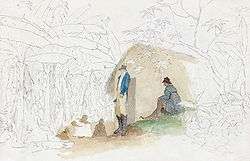Plantation (settlement or colony)
Plantation was an early method of colonisation where settlers went in order to establish a permanent or semi-permanent colonial base, for example for planting tobacco or cotton.[1] Such plantations were also frequently intended to promote Western culture and Christianity among nearby indigenous peoples, as can be seen in the early East-Coast plantations in America (such as that at Roanoke). Although the term "planter" to refer to a settler first appears as early as the 16th-century, the earliest true colonial plantation is usually agreed to be that of the Plantations of Ireland.

The word "plantation" was applied to the large farms that were the economical basis of many of the 17th-century American colonies. The peak of the plantation economy in the Caribbean was in the 18th century, especially for the sugar plantations that depended on slave labour. Most of that time Britain prospered as the top slaving nation in the Atlantic world. More than 2,500,000 slaves were transported to the Caribbean plantations between 1690 and 1807. Because slave life was so harsh on these plantations and slaves died without reproducing themselves, a constant supply of new slaves from Africa was required to maintain the plantation economy against this "natural decrease".[2] In 1789 the French colony of Saint-Domingue, producer of 40 percent of the world's sugar, was the most valuable colony on earth. Slaves outnumbered whites and free people of colour by at least eight to one, but provided nearly all of the manual labour, and essentially all of it on the plantations. Slave labour made sugar production profitable. Importing sugar to Great Britain resulted in a dramatic change in the eating habits of Britons, one of the greatest in human history. In 1700, Britons used an average of four pounds of sugar a year, but by 1800 they used an average of 16 pounds a year.[2]
Ireland
The Plantations of Ireland were an instrument of retribution and colonisation after several Irish rebellions against English rule throughout the 16th and 17th centuries. The largest settlement, the Plantation of Ulster in the northern part of the island, was established following the rebellion of Hugh Roe O'Donnell and Hugh O'Neill in the Nine Years' War (1594-1603). The plantations were seen as part of process that would Anglicise Ireland, as well as a means of maintaining English political control in Ireland. Lands were seized from the native landowners both as punishment for rebellion and as punishment for remaining Catholic rather than conforming to the (Protestant) established church. These lands were given to English (and later, Scottish) Protestant settlers who would be loyal to the Crown and keep the native Irish under control.
Scottish Highlands
During the Middle Ages, the Scottish government planted Scots-speaking lowland merchant colonies in the Gàidhealtachd (the Gaelic-speaking part of Scotland), for example at Campbeltown and Cromarty.
North America
Jamestown, Virginia was the first permanent English settlement in North America. During the 17th century, the Chesapeake Bay area was immensely hospitable to tobacco cultivation. Ships annually hauled 1.5 million pounds (680,000 kilograms) of tobacco out to the Bay by the 1630s, and about 40 million pounds (18 million kilograms) by the end of the century. Farmers responded to falling prices by growing even more tobacco. The labour supply from Africa (slaves) was expensive. In the 17th century, farmers relied on indentured servants for labour. To encourage settlement of the colonies, the Crown granted land to colonists who paid for workers and other settlers under a headrights system. The planters replaced tobacco with other crops after the soils became exhausted in the coastal areas. Cotton was produced on plantations on the Sea Islands off South Carolina and Georgia.
The economy of the South changed markedly beginning in the early nineteenth century, as the invention of the cotton gin made cultivation of short-staple cotton profitable across vast areas of the upland Southeast. Settlers poured into what became known as the Deep South, putting pressure on the federal government to remove the Native American tribes from the Southeast. In the 1830s, the government forced most of the Five Civilised Tribes to Indian Territory west of the Mississippi River, leading to rapid development of extensive cotton plantations across the South to eastern Texas. Cotton was king, and worldwide demand for American cotton resulted in growing wealth among planters in the South, wholly dependent on enslaved labour.
European colonists did not regard the land as belonging to the tens of thousands of Native Americans who occupied it, because their patterns of use were so different. The Plantations of New England were considered to occupy "virgin" land or wilderness. The Plymouth Plantation, was settled to create a new beginning for English dissenters and, as such, was essentially utopian. Later plantations were more overtly entrepreneurial: European investors funded colonists in the expectation of good returns. Examples of the latter include the Massachusetts Bay Colony, the New Haven Colony, the Dutch settlement of New Amsterdam (now New York), and the French in Canada, where they named their colony as New France .
In the state of Maine, the old meaning has been preserved in the name of a type of local government jurisdiction. It is also preserved in the full name of Rhode Island: the "State of Rhode Island and Providence Plantations."
References
- "Etymology of plantation". Online etymology dictionary. Online etymology dictionary. Retrieved 27 April 2016.
- Rogozinski, Jan (1999). A Brief History of the Caribbean (Revised ed.). New York: Facts on File, Inc. pp. 110, 126, 141–142. ISBN 0-8160-3811-2.
- Albert Galloway Keller, 1908, Colonization: A Study of the Founding of New Societies, Bastion: Ginn & Company